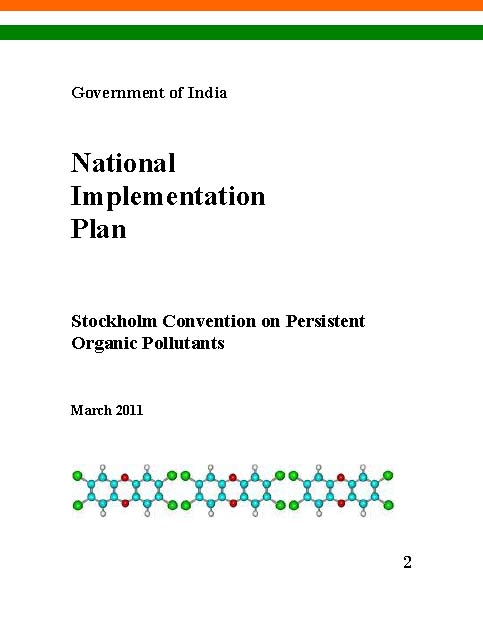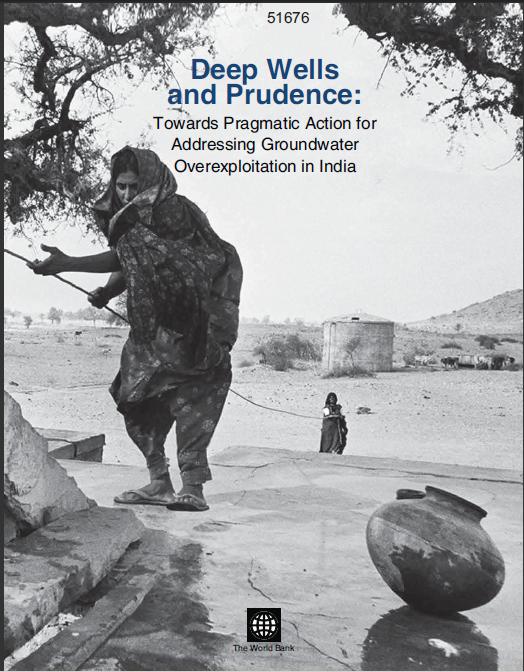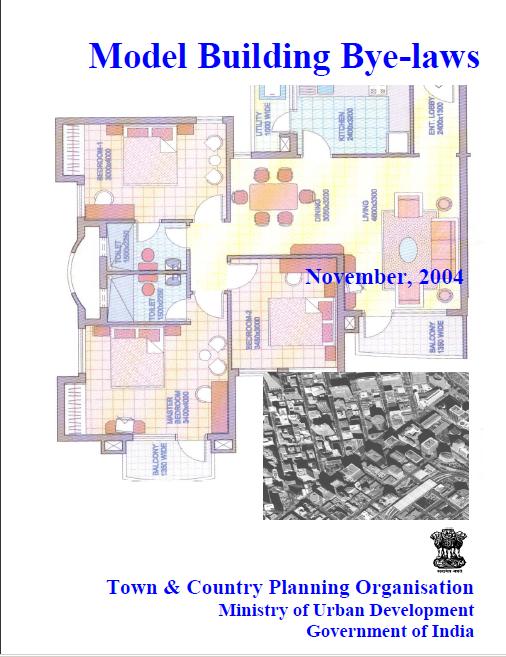Policies, Laws and Regulations
Stockholm Convention on Persistent Organic Pollutants – Draft National Implementation Plan by the Ministry of Environment and Forests (2011)
Posted on 14 Apr, 2011 07:35 AM As per Article 7 of the Stockholm Convention, countries are required to develop the National Implementation Plan (NIP) of the Stockholm Convention on Persistent Organic Pollutants (POPs) to demonstrate how the obligations under the Convention would be implemented. The Convention was adopted with the objective of protecting human health and the environment from POPs and came into force from April 2006 in India.
As per Article 7 of the Stockholm Convention, countries are required to develop the National Implementation Plan (NIP) of the Stockholm Convention on Persistent Organic Pollutants (POPs) to demonstrate how the obligations under the Convention would be implemented. The Convention was adopted with the objective of protecting human health and the environment from POPs and came into force from April 2006 in India.
The Ministry of Environment and Forests, which is the nodal ministry for the Global Environmental Facility (GEF) and Stockholm Convention in India has prepared a NIP and has committed itself to its implementation subject to adequate assistance. It has had to harmonize the interests and stand points of different sectors involved and thereafter determine the position of the Indian government.
India understands that compliance with the obligations on Parties set out in the Convention will have a significant and positive influence not only on India‘s own chemicals management regime but also on the ultimate global success of the Convention. Since among the POPs only Dichloro Diphenyl Trichloroethane (DDT) and Polychlorinated Biphenyls (PCBs) are used in the country the inventory concentrated on DDT storages and facilities where PCB-containing electrical equipment was found.
"A rock and a hard place" and "Tackling the P problem" - Dependence of agriculture on phosphate fertiliser - Issues and the way out - Papers by Soil Association and J Venkateswarlu
Posted on 13 Apr, 2011 12:17 AMThese two reports discuss the dependency of agriculture on phosphorous and the ways to mitigate the problem.
The first report looks at agricultural dependence of chemical nutrients on a global scale and even discusses the potential international political fallout of a reduction in phosphorous. The second report is focused on ways to tackle the dependency on this mineral, in the Indian context. However, both speak of the need for finding alternatives to the current methods of obtaining phosphorous, which is largely through mining.
MoRD is inviting comments from the public on the draft version of the MGNREG Audits of Schemes Rules, 2011
Posted on 12 Apr, 2011 07:10 PMDeep wells and prudence - Towards pragmatic action for addressing groundwater overexploitation in India - A World Bank document (2010)
Posted on 12 Apr, 2011 01:51 AM India is the largest user of groundwater resources in the world. It is estimated that approximately 230 cubic kilometers per year is used annually, this is more than a quarter of the total world consumption from this resource.
India is the largest user of groundwater resources in the world. It is estimated that approximately 230 cubic kilometers per year is used annually, this is more than a quarter of the total world consumption from this resource.
It is in this context that this World Bank report looks at the reasons for this quantum of groundwater usage.
The report delves into socio-economic and political reasons and looks at policies which inadvertently promote so much extraction. The report also analyses various attempts to manage this resource. These attempts range from government and international agency efforts directed to grassroots mobilisations. Finally the report comes out with suggestions to deal with this crisis.
Model building bye-laws, developed by the Town & Country Planning Organisation - Ministry of Urban Development (2004)
Posted on 11 Apr, 2011 03:11 AM Building bye-laws are a set of standards used to regulate various facets of a building everything from its design to its safety features. In these 'Model Building Bye-Laws', the Town and Country Planning Organisation (TCPO) under the Ministry of Urban Development (MoUD) has created a guide for State Governments, Urban Local Bodies, Development Authorities to help them play a more effective role in enforcing the implementation of the master plans.
Building bye-laws are a set of standards used to regulate various facets of a building everything from its design to its safety features. In these 'Model Building Bye-Laws', the Town and Country Planning Organisation (TCPO) under the Ministry of Urban Development (MoUD) has created a guide for State Governments, Urban Local Bodies, Development Authorities to help them play a more effective role in enforcing the implementation of the master plans.
Techno-economic feasibility study of sanitation and sewage management for Pandharpur town, Maharashtra - Ecosan Services Foundation (2009)
Posted on 10 Apr, 2011 02:15 AM This study provides interventions to solving the sanitation crisis in the holy town of Pandharpur, situated on the banks of the Chandrabagha/Bhima river, in the state of Maharashtra, which receives more than 1.5 crore devotees annually. On any given day there are approximately 20,000 pilgrims in this Class B town. This vast floating population creates massive sanitation problems leading to environmental and hygiene issues. The study forms part of the Maharashtra State Pollution Control Board's 'Environmental Improvement Programme at Religious Places in Maharashtra' project.
This study provides interventions to solving the sanitation crisis in the holy town of Pandharpur, situated on the banks of the Chandrabagha/Bhima river, in the state of Maharashtra, which receives more than 1.5 crore devotees annually. On any given day there are approximately 20,000 pilgrims in this Class B town. This vast floating population creates massive sanitation problems leading to environmental and hygiene issues. The study forms part of the Maharashtra State Pollution Control Board's 'Environmental Improvement Programme at Religious Places in Maharashtra' project.
MoEF reconsitutes the National Coastal Zone Management Authority
Posted on 24 Mar, 2011 01:32 PMthe Central Government constituted the National Costal Zone Management Authority for a period upto the 31st December, 2010.
And whereas, the Central Government is of the view that such an authority must be reconstituted.
National mission for a green India - Presentation to the PM's council on climate change - Latest update from the MoEF
Posted on 22 Mar, 2011 04:15 PMThe draft was made available in 11 languages.
There were 7 regional consultations held at Guwahati, Dehradun, Pune, Bhopal, Jaipur, Vizag and Mysore over a month and a half starting from 10th June to 15th July and attended by the Minister and the team.
43 projects sanctioned under Mission Clean Ganga - MoEF press release
Posted on 22 Mar, 2011 12:44 PM It's mandate is to ensure effective abatement of pollution and conservation of the river Ganga by adopting a holistic approach with the river basin as the unit of planning.
Preparedness for tsunami-like disasters - MoEF Press release
Posted on 18 Mar, 2011 01:07 PM
In the background of recent Tsunami tragedy that has struck Japan,concern has been raised in India on the safety of critical infrastructure projects located in the coastal areas, for instance, power plants, oil storage depots, refineries etc. More such projects are likely to come up in the coastal locations in the years to come.
Hazard Line Mapping
In this connection, it may be recalled that a very important component of the Rs.1200 crore project taken up by the MoEF for implementation involves identification, delineation and demarcation of the hazard line along the 5400 kms of the main coastline of India.